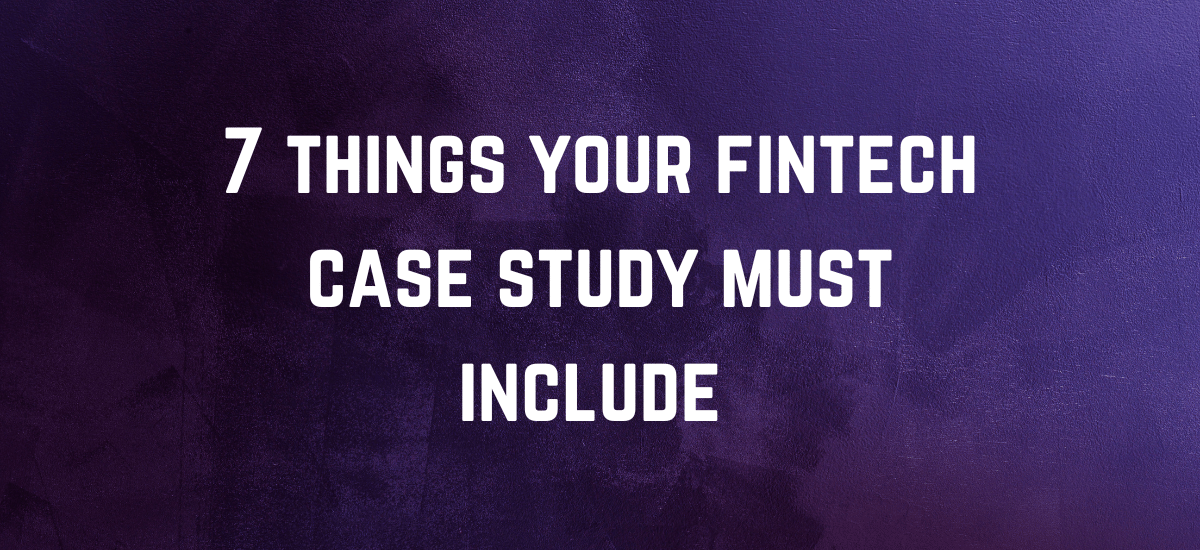by deborah
Share
by deborah
Share

The emerging financial technology market is one of the hottest and trendiest up-and-coming sectors. As such, competition is fierce as companies rush to establish a foothold in the space and claim their market share.
Having an excellent FinTech product or service is only half the battle; the other half is actually catching people’s attention and getting them to take action; unfortunately, all too often, that’s easier said than done. The companies who are thriving in the FinTech space have figured out the equation and, in doing so, have set themselves apart from the crowd.
In this comprehensive guide, you’ll learn how the most successful FinTech companies have managed to capture their audience’s attention and convert their target demographic into loyal, paying customers. By following their formula, you too can elevate yourself above the competition and thrive where others fail.
Identify your Target Demographic
The first step towards gaining high-value customers is identifying who they actually are. You could have the best payment solution in the world, but if nobody knows about it, you will not make a cent. You have to make yourself visible to the people who need your services, the CEO’s, CFO’s and small business owners who will benefit by working with you. These are the people for whom you are solving a problem, and they are the same people who can solve yours. Get deep with who your target person is, here are some questions to ask yourself that will prove incredibly valuable long-term:
- What does your target person do in the morning, do they head straight for the TV, check their emails, scroll through LinkedIn, or post up a TikTok?
- What they do before bed, do they check Facebook or look at Instagram?
- What are their favourite brands? Check out those brands and get inspired.
- What drives them? Are they driven by their family, by wealth, do they want to move country, do they want to get married?
- Where do they go when they have a question? Reddit, Facebook groups or do they read articles? If they read articles for information, what media channels do they use?
- Where are they in the world right now?
But how do you target your desired demographic? There are a few proven strategies for making sure that your ads end up on the right computer screens; let’s take a look at them.
Here are the top five strategies for reaching your desired audience and successfully marketing your FinTech product or service.
1. Be present and active on the right social media platforms
These days, there are many social media outlets at your disposal, but directing your marketing efforts towards the wrong platform is a costly and futile mistake. An ad that will convert with seniors preparing for their retirement will not work with millennials who are just getting started in their careers or Gen-Z who are still in college or high school. You need different ads for different people on different social media sites. You may be selling them all the same product, but you need to sell it in very different ways.
Let’s touch on some social media platforms and go over who is most active on those sites and what you might try to find success on each platform.
Most of the active users on Twitter are between the ages of 30-49. The vast majority (69%) are male; this means that Twitter is a great place to target those established in their careers, buying houses, getting married, and starting families. So, if you want to be successful in marketing your FinTech products or services on Twitter, consider ads that solve problems relating to the big events in life, as that’s what this demographic is presently going through.
These days, Instagram has way more active users than Twitter, with over a billion people using the platform every day. The largest age group on Insta is 25-34 year-olds, with 57% of users being female and 43% being male. So, these are people that are fresh out of college, who are just starting their careers and probably don’t have the sort of money that the older Twitter crowd in their 40’s will have. For that reason, you should create ads that focus more on savings rather than retirement solutions if you want to have success on Instagram.
This is probably the most lucrative social media platform for attracting high-paying, high-value customers for your FinTech company. The reason for this becomes apparent when you look at the numbers. The average age of active users on LinkedIn is between 46-55 years, which means that these are established people with money who are in need of Fintech products and services. Focus your LinkedIn campaigns around retirement and offer your more expensive services here where you will be more likely to convert.
TikTok
TikTok is where you want to advertise to build brand affinity with Gen-Z. The average age of users on TikTok is around 18 to 24 years old, with the majority (59%) being females. Young women in this age group have more money than ever before, thanks to the meteoric rise of social media monetization, so you can definitely convert leads on TikTok, but avoid terms like investment portfolio or retirement funds at all costs. Ensure that your TikTok ads are fresh, fun and light, or you will risk alienating this demographic.
After 17 years in business, Facebook is still the king of social media platforms. However, that is likely to change in the coming years as Instagram is gaining ground rapidly and Facebook is in decline. That said, there are still more than 2.7 Billions active users on Facebook (almost triple the number of Instagram users) and so you can reach the largest possible audience on FB. Facebook ads are one of the best tools in any marketing blueprint, and failing to use Facebook ads will hurt your bottom line.
The thing is that with such a diverse demographic, it can be challenging to customize your ads for each individual on Facebook, and that’s where keyword research comes into play. Let’s take a closer look at that now.
2. Use SEO targeted keywords specific to your demographic
When someone enters a search term on Google, for example, Google will search the internet and return a list of web pages that feature the words used in the search. These are known as keywords, and they are one of the most powerful tools in any marketing playbook. By knowing the keywords that your target audience is searching for, you will be able to target your desired demographic with tremendous precision.
This is also how you want to target your Facebook ads; conduct keyword research to find FinTech related search terms and then create content or ads which feature those exact terms; this WILL increase your reach, promote brand awareness, and generate exponentially more revenue from your marketing efforts.
But how do you find the right keywords? Well, that’s the billion-dollar question; it’s more of an ever-evolving art rather than a science, but here are a few tips.
- Start by typing a relevant search term in Google and pay attention to Google’s autocomplete suggestions; those are the top keywords related to that search term.
- Use Google’s keyword planner tool to gain market insight
- Use a premium keyword research tool such as ahrefs or SEMrush.
- If you have a smaller budget, use Ubersuggest for lightweight SEO.
Once you know what people are searching for, you can find the people who are already interested in FinTech products and services. Those people will be much easier to convert than random people who may have no interest in your products whatsoever.
A pro tip is to target keywords that have a good volume of traffic without much competition. Targeting the top keywords isn’t a great strategy because hundreds of other companies are doing the same thing; look down the list and pick keywords that are relevant but which you can rank for easily.
3. Provide valuable content that helps people
Using the right keywords in your social media ads is an absolute must if you want to be successful, but social marketing is only one avenue for potential conversions.Other great ways to attract new customers include blogging, video creation or anything else that provides valuable content to your demographic and helps them solve a problem.
Leverage the power of YouTube and post videos (with good keywords in the title) to attract viewership that you would otherwise be missing out on. By helping people solve a problem, you will build trust, increase your brand recognition and ultimately generate more revenue.
The web is full of hollow, low-value, keyword-stuffed content, so be different. Spend the time to help your audience solve a problem, and in turn, they will be more willing to trust and do business with you.
4. Always include meta-data and use proper web syntax
If you decide to start a blog (which you definitely should), you need to make sure that you are formatting your content correctly. The internet continues to evolve, and Google’s search algorithm is evolving alongside it. When Google scans a blog post, it doesn’t know what it’s looking at; you have to tell it.
You need to use the proper HTML tags, so always make sure you have a title and h1 with your keywords included; this tells Google, “Hey, my blog post is relevant to people searching for this term”, you also want to include meta-data which again says “Hey Google, look… my content is about this”.
You should also title your images correctly, link internally between your content and send your favourite blog posts out to media channels that might find your content interesting enough to link back to it.
If Google can’t tell what your post is about, then you won’t rank highly, so this is of the utmost importance and can make all the difference when it comes to FinTech content marketing for your company.
5. Follow-up with people who have engaged with your brand
Attracting new visitors to your website means nothing if they don’t actually sign up or buy what you’re selling. In most cases, unless you are selling a physical product, people aren’t going to buy on the first visit, so you need to follow up with them; fortunately, there is a great way to do that which has been proven to work effectively. Let’s take a close look at this because it’s very important.
Email Marketing
You can’t follow up with people if you don’t have their contact information. If you can somehow get their name and phone number, then fantastic! You are way ahead of the game. The problem is that people don’t like giving their names and personal contact info to companies that they don’t know and aren’t doing any business with.
An email address, on the other hand, is much less personal than a phone number and in most cases, people who might be interested in your service will be happy to provide you with their email address as long as there is something in it for them.
The trick is to offer them something of value in exchange for their contact info. Maybe you can give them a free trial, or a discount, or an upgrade, or a coupon code; anything that they will perceive as being of value to them can do the trick.
Once you have that info, reach out to them and offer them another incentive to sign-up today, don’t spam them or be pushy; just have a product or service that will benefit them and politely remind them of that. Email marketing is the number one way to reverse shopping cart abandonment and increase your conversions.
Summary
As more and more FinTech companies get off the ground, the competition in this already crowded space will only increase. By following a few simple tips, you can position your company in the best possible way to ensure that you rise to the top and build something that will last.
First and foremost, you need to know who your target audience is. Once you identify your desired demographic, tailor your ads and marketing efforts specifically for them. You can do this easily by leveraging a FinTech content writer. Then, put your ads on the right social media channels to get the best results, make sure that you’re doing your homework, and find the best keywords for each campaign. Always provide valuable content that solves problems for people and triple-check that your content is formatted correctly so that Google knows what you’re trying to achieve. Finally, reach out to people who have already engaged with your brand or visited your site. By doing these things, you will have the best chance of seeing consistently high ROIs from your FinTech marketing efforts.




